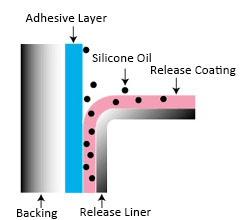Why Does Silicone Migrate to PSA Surface?
2021/07/03
So, let’s talk about sticky things – more specifically, those pressure-sensitive adhesives, or PSAs for short. They’re used in a bunch of stuff, like your everyday post-it notes or protective films. Usually, they’re slapped onto a silicone-coated release liner, which is just a fancy term for something that stops things from sticking to it.
But here’s the deal: sometimes, that silicone gets a little adventurous and makes a trip from the liner to the sticky part of the PSA. Why does this happen, you ask? Well, let’s dive right in.
Silicone Migration
One reason is all about balance. You know how everyone says the universe loves balance, right? It’s no different at the molecular level. Substances like to move from areas where they’re packed tight (high concentration) to places where they can breathe a little (lower concentration), until everything’s nice and balanced. This migration game is pretty much run by intermolecular forces – think of them as the glue that holds everything together. If this ‘glue’ between the silicone and the PSA is stronger than the one keeping the silicone molecules together, you bet that silicone is gonna migrate.

Then, there’s the role of heat and time. The hotter it gets, or the longer the PSA hangs out with the silicone-coated liner, the more likely the silicone is going to move. Picture this: with more heat, the silicone molecules are like hyperactive kids running around, increasing the chance they’ll stick to the PSA.
Next up is the condition of the silicone itself. If it’s not properly cured or crosslinked (which is just a way to connect the molecules into a stable 3D network), it’s more likely to break away and migrate. Imagine trying to hold a bunch of marbles together – if they’re not secured properly, some are bound to roll away.
Finally, there’s compatibility. It’s a bit like dating, really. Some adhesives and silicones are just more into each other than others. If they’re chemically compatible, the silicone is more likely to get cozy with the adhesive.
Now, this whole silicone migration business isn’t always great. Why? Because when silicone decides to wander over to the adhesive, it can act like a third wheel, making the adhesive less effective at doing its job of sticking things together.
How to Reduce Silicone Oil Transfer?
Alright, so you’re dealing with some silicone oil transfer, huh? That’s when the silicone oil decides to take a little journey from one place, like a release liner, to another place, like a pressure-sensitive adhesive (PSA). This silicone migration can mess up the stickiness of your adhesive, which isn’t ideal.
So, how do you tell that pesky silicone oil to stay put? Let’s break it down.
1. High-Quality Silicone Release Liners:
This is like buying the good stuff at the grocery store instead of the generic brand. Higher quality silicone release liners are often made with better curing processes, meaning the silicone oil is less likely to migrate because it’s better bound to the liner.
2. The Right Temperature and Storage:
Like a fine wine, adhesives and silicone liners need to be stored correctly. This means keeping them at a moderate temperature and away from sunlight or any heat source. High temperatures can cause silicone molecules to get a bit too excited and start wandering off.
3. Good Old Testing:
Before you go full steam ahead with a batch of adhesive, do some testing first. Try out different types of silicone coatings and curing methods to see which ones result in the least amount of silicone oil migration.
4. Find the Right Match:
Not all adhesives and silicones are a match made in heaven. Some combinations are more likely to lead to silicone oil migration. If you’re seeing a lot of silicone oil transfer with your current setup, it might be time to play matchmaker and try out a different adhesive.
5. Crosslinkers and Catalysts:
If the silicone oil on your liner is moving around too much, you could add some crosslinkers or catalysts into the mix. These substances can help create a more stable structure for the silicone oil, making it harder for it to break free and migrate.
If the product cannot have any silicone migration, a non-silicone release liner or a fluorosilicone release liner can be used instead of the silicone release liner.
Category
